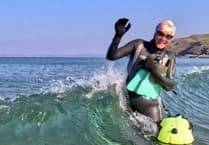Calls have been made this week for a properly trained lifeguard to be stationed at Saundersfoot beach during the summer months.
HM Coroner for Pembrokeshire, Mr. Michael Howells, said this should be one of the main safety precautions carried out after hearing how a five-year-old boy drowned when his inflatable dinghy was swept away by the tide in August.
An inquest in Milford Haven yesterday (Thursday) was told that little Ryan Ingram, of Kington, Hereford, had been on a short-break holiday in the village with his parents Michael Ingram and Christine Doman in August.
PC Nigel Lewis, of Tenby, said that during the break Ryan, who had no fear of the water, had persuaded his parents to purchase a one-man toy inflatable dinghy.
As he could not swim, his parents always insisted that he wore armbands while in the water, but he often removed them when they were not looking.
On the last day of their holiday, August 24, the family had again visited Saundersfoot beach and Ryan, supervised by his father, had played happily in the sea with the dinghy for about half-an-hour while Ms. Doman had been shopping in the village.
On her return, the family 'set up camp' on the beach just below The Strand.
However, while Mr. Ingram was wiping some sand off Ryan's bottle of drink, Ms. Doman noticed the youngster running back into the sea with his dinghy.
He had left his armbands and Mr. Ingram ran after him with them, but by the time he reached the water's edge, the little boy was in the dinghy and was already some 20 yards off shore.
DINGHY SWEPT OUT
Mr. Ingram waded out, but the dinghy was being carried further away by the ebb tide and off-shore wind.
Although he was not a strong swimmer, admitting to only swimming while on holiday, Mr. Ingram plunged after the dinghy and got within three feet, but it kept being swept out of his grasp.
Experiencing difficulties and swallowing water, Mr. Ingram decided to return to the shore to get help.
A father and daughter, Tony and Karen Vance, of Leicester, were on a sailing weekend in the village and had taken part in a sailing race that morning.
They were packing away their 14-foot sailing dinghy when Mr. Ingram approached them and, after directing Mr. Ingram to the beach attendant's hut on the beach, they re-rigged their yacht and put to sea.
On discovering Ryan floating face down in the water, they took him on board and, as both were trained first aiders, began mouth-to-mouth resuscitation and CPR.
Tenby's inshore lifeboat arrived and the youngster was taken on board, where lifeboat crewmen Ben and Robert James continued CPR while helmsman Lewis Creese headed for the shore.
On arrival on shore, Tenby Coastguard station officer Mike Day, ambulance paramedic Mike Tebbutt and local doctors David Hurle, of Saundersfoot, and Iwan Griffiths, of Tenby, continued CPR until the arrival of an SAR helicopter from RAF Chivenor, which transported the youngster to Withybush Hospital, Haverfordwest.
Unfortunately, he was declared dead on arrival.
A post mortem carried out by Dr. Melville Jones gave the cause of death as drowning.
Mrs. Margaret Rayanne Jones, of Ammanford, told the inquest that she had been on the beach with her family and had been paddling in the sea with her grandchildren.
She had noticed the young boy in the dinghy and was a little concerned because he appeared to be on his own.
Little Ryan had spoken to her grandchildren, but when she asked him if anyone was with him, he had not answered.
Mrs. Jones said that she was in the water up to her waist and she could feel the pull of the tide.
She noticed Mr. Ingram wading out and then starting to swim after the dinghy. She had then witnessed him experiencing difficulties and turning back to get help.
By this time the little boy was on his knees in the dinghy.
"He was drifting towards a big boat and I thought that if he could reach it he would be safe," said Mrs. Jones. "Then I saw the boat capsize and I heard a splash.
"I yelled after Mr. Ingram to tell him, but I couldn't help because I can't swim and my grandchildren were becoming distressed."
In a written statement, Mr. Vance confirmed that he had been on a sailing holiday with his wife and daughter and had put to sea with his daughter following Mr. Ingram's request for help.
He estimated that around 10 minutes had elapsed from the time Mr. Ingram had raised the alarm to the time they found the youngster floating face down approximately 500 yards of shore.
BEACH ATTENDANT
Andrew James Miller, of Serpentine Road, Tenby, explained that he had a holiday job employed by Pembrokeshire County Council as a beach attendant in Saundersfoot.
His responsibilities included patrolling the beach, giving minor first aid, keeping dogs off the restricted areas and being first point of contact in event of an emergency, although he added that he was not a trained lifeguard.
He was equipped with a mobile 'phone and the beach attendant's hut also had a radio for communications with his superiors in Tenby.
He said he had been doing the job since the end of June and it was an average sunny summer's day and the beach was quite full.
When Mr. Ingram contacted him to raise the alarm he had 'phoned Milford Haven Coastguard, but found the line engaged.
He had then contacted the Tenby Coastguard station and alerted sector manager Dave Miller who told him to inform Milford by ringing 999 while he prepared a response.
Mr. Miller then went along the beach to see if he could find members of the public with sailing craft who could assist.
While trying to attract the attention of some canoeists he heard the Coastguard sirens and had gone back to the slipway to meet them.
Mr. Dave Miller explained he was sector manager for the South Pembs. area, covering from the east bank of the River Towy to Wooltack Point on the Dale peninsula.
He explained that Milford Haven Coastguard had been officially alerted at 11.42 am that a child was being swept out to sea off Saundersfoot beach, but he had been made aware of the situation a couple of minutes earlier via a direct call from the Saundersfoot beach attendant.
Mr. Miller had immediately initiated a response by Tenby Auxiliary Coastguard who were already on their way into the station office in response to another call to deal with a trapped bull on Caldey Island.
Milford Haven broadcast an alert to all marine vessels in the vicinity of Saundersfoot and tasked Tenby inshore lifeboat and the Coastguard to the scene.
On hearing that the child was in the water, they also requested the launch of Tenby's all-weather lifeboat, the RFA Sir Galahad, and helicopter assistance from Air Rescue Co-ordination Centre Kinloss.
Both the ILB and Coastguard units arrived on scene at 11.53 am.
Mr. Miller said that at that time of the day the tide was at full ebb with a 0.2 to 0.3 knot offshore current.
Winds were gusting northerly around force four and the tide and wind had conspired to carry the dinghy out to sea.
'TOTALLY
UNSUITABLE'
Mr. Miller said that these conditions were 'totally unsuitable' for using inflatable toys in open sea.
The sector manager said that personally he would not like to see such inflatables used in open sea at all, but if they were, to ensure safety they should be tethered to the shore and their use supervised by an adult.
He added that the Coastguard Agency promoted a Sea Smart Code in an effort to prevent accidents such as these and the code was given a high priority at the start of the summer period.
Mr. Howells noted Saundersfoot beach's European Blue Flag status, one of the criteria for such status being safety, and he asked the local Coastguard chief what the safety measures were.
Mr. Miller replied that the only one he was aware of was a beach attendant who, along with his other duties, acted in the role of a first point of contact in an emergency.
Mr. Howells wondered if a rescue boat on the beach would be viable.
Mr. Miller said that the Coastguard would love to have such craft on every beach, but with some 50 in Pembrokeshire alone, it was not financially possible.
He said a more practical and effective option would be to provide trained lifeguards on the beach during the summer which would supply both a preventative and reactive response to likely incidents.
TRAGIC CASE
Extending his sympathy to Mr. Ingram and Ms. Doman, Mr. Howells said that this was a tragic case.
"Little Ryan was well cared for and his parents acted responsibly while he was playing in the sea, always ensuring he wore armbands," he said.
"However, like most five-year-olds, he could be full of mischief and ran off down to the water without the armbands.
"Mr. Ingram tried to stop him, but by the time he got to the water's edge he was already being carried off by the tide.
"With just 11 minutes between the call and arriving on scene, I do not think there can be any criticism of the responses of the emergency services. Unfortunately, by the time Ryan was picked up by Mr. Vance and his daughter he had already been in the water for 10 minutes, which, even for adults, is an impossible length of time."
While recording a verdict of accidental death, Mr. Howells said that it was also within the remit of an inquest to draw lessons to avert a similar tragedy.
"In the first instance, I would say that these dinghies should not be sold at all," he said. "If they are going to be sold, then they should be sold with a safety line and instructions.
"Thirdly, there ought to be increased safety on this beach.
"I'm not saying it is a dangerous beach, but it has Blue Flag status and something has to be done to make all the precautions necessary if it wants to keep that status.
"I fully endorse the recommendation that there should be trained lifeguards present."



